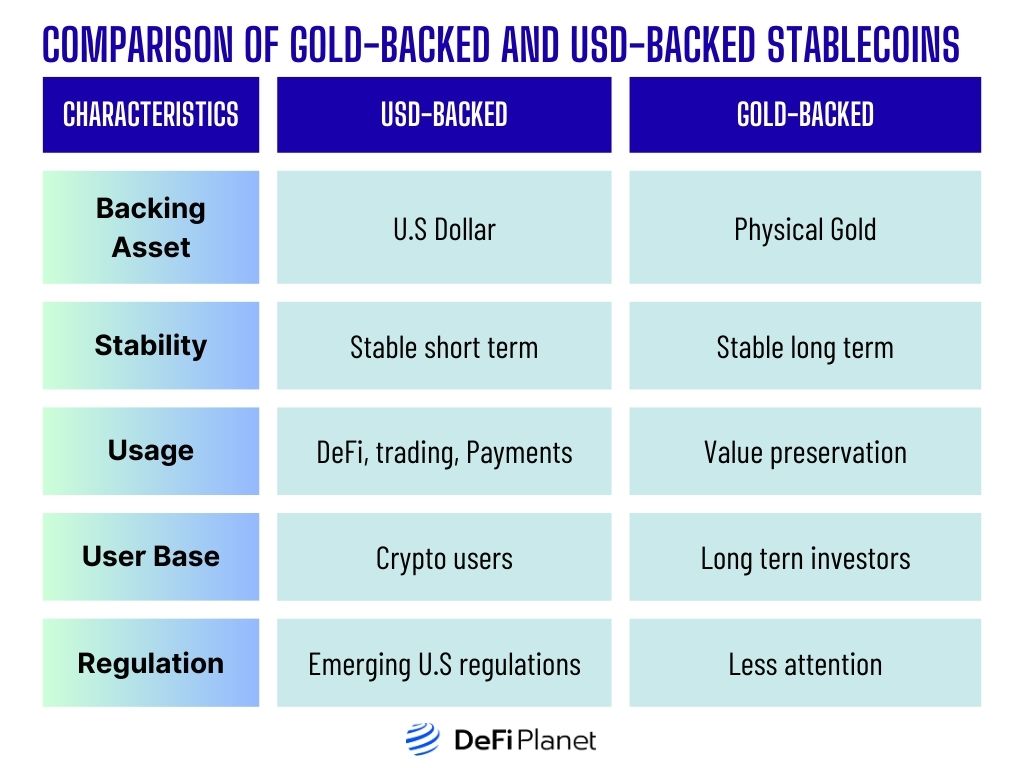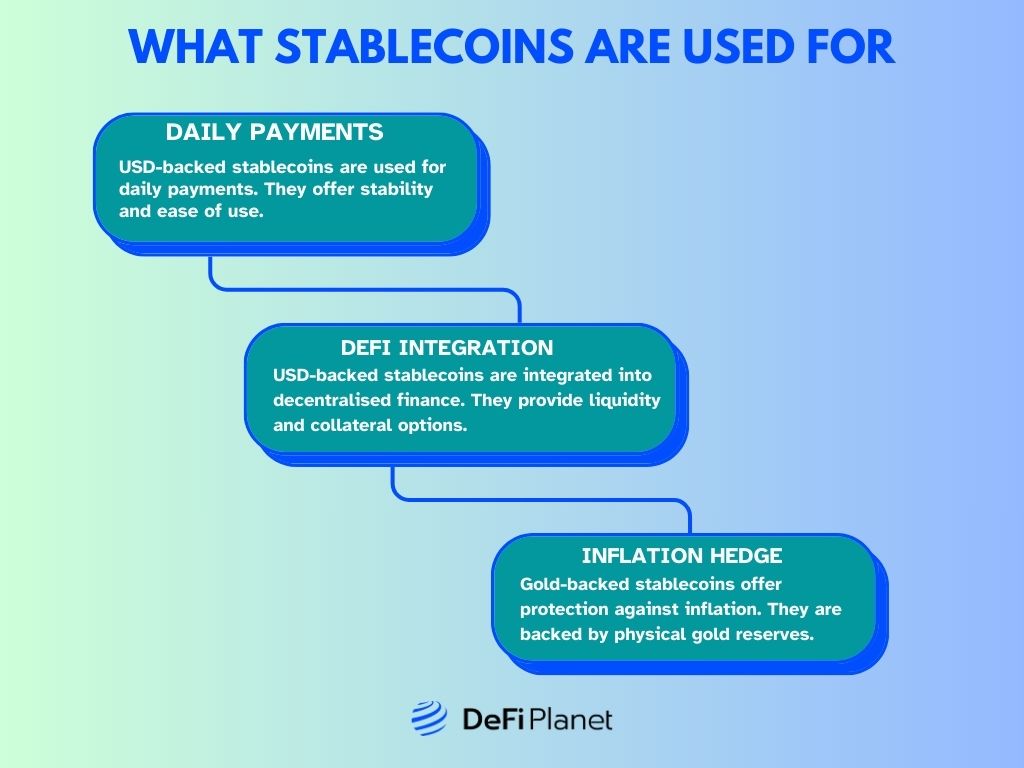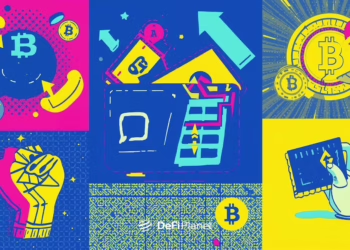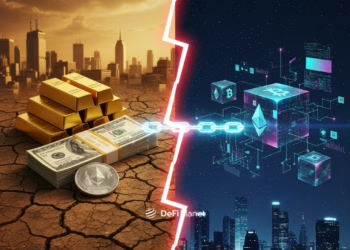Stablecoins have emerged as one of the most important tools for navigating the crypto economy. Designed to offer price stability in a space known for volatility, stablecoins provide a crucial bridge between traditional finance and blockchain-based innovation. But not all stablecoins are created equal. Two dominant categories—USD-backed and gold-backed stablecoins—have taken center stage, each offering unique benefits and trade-offs depending on a user’s financial goals, risk tolerance, and market outlook.
This article dives deep into how these two types of stablecoins compare—exploring what backs them, how they perform, where they’re used, who relies on them, and what the future might hold. Whether you’re a crypto trader, long-term investor, or simply exploring the digital asset landscape, understanding the distinction between these stablecoins is key to making informed financial decisions in an increasingly digital world.
What Are Gold-Backed Stablecoins?
Gold-backed stablecoins are a type of digital currency whose value is directly tied to real-world gold. Each gold-backed stablecoin represents a fixed amount of physical gold. This gold is stored securely in vaults by a trusted custodian, and the issuer ensures that an equivalent amount of actual gold matches every token in circulation.
The purpose of these tokens is to offer a digital way to own gold without the hassle of physically buying, storing, or insuring it. Instead of holding bars or coins, you hold a token on the blockchain that can be easily traded, transferred, or used within decentralized finance (DeFi) platforms. If needed, many of these tokens can also be redeemed for the equivalent value in gold or fiat currency, making them both flexible and practical.
What sets gold-backed stablecoins apart is their ability to track the real-time market price of gold in a stable manner. If the value of gold rises, the price of the stablecoin also increases. Likewise, if it drops, the stablecoin’s value adjusts accordingly. Because the backing asset—gold—is widely recognized as a safe-haven investment, these stablecoins are often viewed as more stable than cryptocurrencies tied to fiat currencies, which can fluctuate due to inflation or political instability.
In regulatory terms, gold-backed stablecoins are often categorized as commodity-backed or asset-referenced tokens. Their classification depends on the laws of the region in which they operate.
Popular examples include:
- Tether Gold (XAUT) – A gold-pegged token by Tether that can be traded and, in some cases, redeemed for actual gold.
- Paxos Gold (PAXG) – Issued by Paxos, this token is backed by gold stored in London vaults and is known for its transparency and regulatory compliance.
- Alloy (aUSDT) – A synthetic gold-backed token collateralized by XAUT and designed to expand gold’s use in DeFi.
In essence, gold-backed stablecoins offer the best of both worlds: the historical security of gold and the digital convenience of blockchain. They are especially appealing to investors who want to preserve value, hedge against economic uncertainty, or diversify their crypto portfolios with an asset that has stood the test of time.
What Are USD-Backed Stablecoins?
USD-backed stablecoins are a type of cryptocurrency designed to maintain a stable value equivalent to that of the U.S. dollar. For every stablecoin issued, the company behind it promises to hold an equivalent amount in reserves—typically in cash or highly liquid, dollar-denominated assets, such as short-term U.S. Treasury bills. This 1:1 backing is what gives these digital tokens their “stable” identity.
The main idea is simple: while traditional cryptocurrencies like Bitcoin or Ethereum can fluctuate wildly in price, USD-backed stablecoins are designed to remain stable, ideally maintaining a value of around $1 at all times. They’re especially useful in the crypto ecosystem because they offer the speed and convenience of digital assets without the rollercoaster volatility. Whether you’re making payments, trading on an exchange, or using decentralized finance (DeFi) apps, these stablecoins act as a reliable bridge between crypto and the traditional financial system.
To use them, you can buy stablecoins like USDT (Tether), USDC (USD Coin), or the now-phased-out BUSD (Binance USD) on most major crypto exchanges. Once you hold them, you can send them across the globe in seconds and use them to pay for goods and services. If you decide to cash out, most platforms let you redeem your stablecoins for U.S. dollars or trade them for other cryptocurrencies.
Read Also: Understanding the Similarities and Differences Between USDT and USDC
What gives people confidence in these tokens is the promise of full backing. Most reputable issuers release public reports, audits, or attestations to show they have sufficient reserves for every coin in circulation. This level of transparency is crucial for trust, especially in a world where crypto users value proof over promises.
That said, USD-backed stablecoins aren’t immune to challenges. There have been rare moments when some tokens temporarily lost their dollar peg—usually due to issues such as banking crises, reserve management risks, or shifts in interest rates. A notable example happened in March 2023, when the failure of Silicon Valley Bank caused a temporary dip in USDC’s value, since a portion of its reserves was tied up in that bank.
Despite occasional hiccups, USD-backed stablecoins remain one of the most widely used and important tools in digital finance. They offer a balance of reliability, liquidity, and flexibility—ideal for anyone navigating both traditional and crypto economies.
Comparison of Gold-Backed and USD-Backed Stablecoins

While both gold-backed and USD-backed stablecoins fall under the same category of “stablecoins,” they are built on very different foundations and serve distinct purposes in the financial and crypto ecosystems. Understanding the differences between them starts with recognizing what supports their value, how they behave in the market, and the roles they play for users.
What backs them up?
At the core, the biggest difference lies in what these coins are tied to. USD-backed stablecoins get their value from U.S. dollar reserves—this means each digital token is supposed to represent one actual dollar kept in a bank account or held in the form of short-term government bonds.
On the other hand, gold-backed stablecoins are pegged to physical gold, often stored in secure vaults. For example, one gold-backed token might be equal to one gram or one ounce of gold. So while both coins aim for stability, one depends on a national fiat currency, and the other on a centuries-old precious metal.
Where are they used?
USD-backed stablecoins are deeply integrated into the crypto economy. You’ll find them everywhere—from centralized exchanges and payment apps to decentralized finance (DeFi) platforms. Their high liquidity and ease of use make them a go-to choice for trading, lending, borrowing, and even sending money across borders. Gold-backed stablecoins, by contrast, are not as widely used in DeFi or on major exchanges. They tend to appeal more to investors who are looking to protect their wealth against inflation or economic instability, rather than those looking for speed or convenience.
How stable are they?
USD-backed stablecoins are known for their short-term price consistency. Because they’re pegged to the dollar, their value rarely shifts unless there’s a disruption like banking issues or regulatory intervention. This makes them ideal for everyday use, like trading or sending money. Gold-backed stablecoins, however, move with the global price of gold. Although gold prices can fluctuate, they tend to rise gradually over time, which makes these tokens attractive for long-term value preservation rather than day-to-day transactions.
Who uses them and why?
The use cases reflect the strengths of each type. USD-backed stablecoins are favoured by traders, developers, and crypto users who need speed, flexibility, and price certainty. They are especially useful for anyone who wants to avoid the ups and downs of other cryptocurrencies but still stay within the digital asset world. Gold-backed stablecoins attract a different kind of user—those who see gold as a reliable store of value and want a way to hold it digitally without dealing with physical gold.
How are they regulated?
When it comes to regulation, USD-backed stablecoins are more in the spotlight, especially in countries like the United States. New laws and proposals, such as the STABLE Act or GENIUS Act, are being drafted to bring more oversight and consumer protection to the stablecoin space. Gold-backed stablecoins, while still under general financial and commodity regulations, don’t yet face the same level of specific scrutiny, though that may change as their popularity grows.
Which One Is Right for You?

Choosing between USD-backed and gold-backed stablecoins depends largely on your financial goals and how you intend to use these digital assets.
If your priority is speed, ease of use, and seamless integration into everyday financial activities like payments, trading, and decentralized finance (DeFi) applications, then USD-backed stablecoins—such as USDT and USDC—are your best bet. These coins offer predictable value, wide acceptance, and regulatory clarity, especially in jurisdictions like the United States, where frameworks are beginning to take shape.
On the other hand, if you’re more concerned with protecting your wealth against inflation, currency devaluation, or geopolitical instability, gold-backed stablecoins like PAXG and XAUT may be more suitable. These tokens offer a modern way to access the historical security of gold, allowing users to preserve value over the long term without physically holding precious metals.
USD-backed stablecoins also shine in cross-border payments and remittances due to their high liquidity and speed. However, when it comes to long-term wealth protection and serving as an inflation hedge, gold-backed stablecoins provide a unique edge.
In the end, the choice isn’t necessarily either-or. A balanced approach—one that combines the instant utility of fiat-backed tokens with the enduring strength of gold-backed ones—may offer the most resilient strategy in a shifting economic landscape. As regulations tighten and the financial world continues to evolve, stablecoins are no longer on the fringe. They are fast becoming central to how value is stored, moved, and preserved in the digital age.
Disclaimer: This article is intended solely for informational purposes and should not be considered trading or investment advice. Nothing herein should be construed as financial, legal, or tax advice. Trading or investing in cryptocurrencies carries a considerable risk of financial loss. Always conduct due diligence.
If you want to read more market analyses like this one, visit DeFi Planet and follow us on Twitter, LinkedIn, Facebook, Instagram, and CoinMarketCap Community.




















